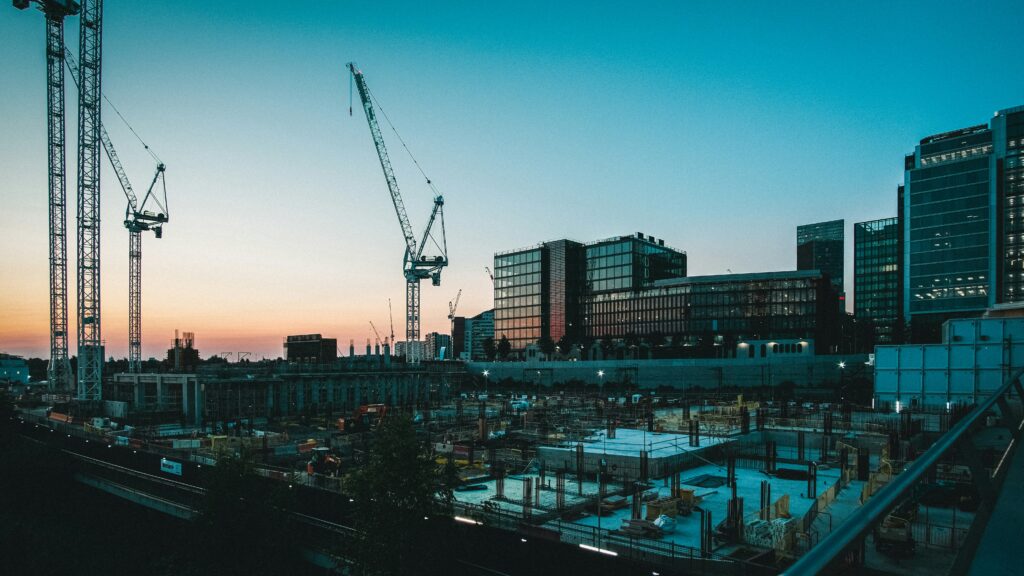US Commercial Construction: Challenges and Opportunities
Posted on Saturday, November 18th, 2023 at 1:01 pm

Photo by Samuel Regan-Asante on Unsplash
The US commercial construction industry is a vital part of the economy, responsible for building and maintaining the infrastructure and buildings that businesses and organizations of all sizes rely on. In 2022, the industry generated over $1.6 trillion in revenue and employed over 7 million people.
However, the commercial construction industry faces a number of challenges, including labor shortages, supply chain disruptions, and rising material costs. Despite these challenges, the industry is expected to grow substantially in the coming years, driven by demand for new and renovated office buildings, shopping malls, healthcare facilities, and other commercial spaces.
Challenges
Labor Shortages
The number one challenge facing the construction industry is a shortage of experienced talent. The industry has been struggling to attract and retain workers for years, and the problem is expected to worsen in the coming years as the workforce ages and more baby boomers retire.
The labor shortage is being driven by a number of factors, including:
A skills gap: The construction industry requires a wide range of skills, from carpentry and plumbing to electrical work and project management. However, many young people are not pursuing careers in the trades, and many existing workers are retiring.
A competitive job market: Construction workers are in high demand across many industries, including manufacturing, energy, and transportation. This makes it difficult for construction companies to attract and retain workers, especially in certain regions.
A negative perception of the industry: The construction industry is often seen as being physically demanding and dangerous, with long hours and low pay. This can make it difficult to attract new workers, especially younger people.
Supply Chain Disruptions
Another major challenge facing the commercial construction industry is supply chain disruptions. The COVID-19 pandemic, the war in Ukraine, and other factors have caused widespread disruptions to the global supply chain, making it difficult and expensive to obtain construction materials.
The supply chain disruptions are impacting the availability and cost of a wide range of materials, including lumber, steel, cement, and glass. This can lead to delays and increased project costs for construction companies.
Rising Material Costs
In addition to supply chain disruptions, the commercial construction industry is also facing rising material costs. This is due to a number of factors, including inflation, increased demand for materials, and higher energy costs.
The rising material costs are putting a strain on construction companies’ margins and making it more challenging to complete projects on time and on budget.
Opportunities
Despite these challenges facing the commercial construction industry, there are also a number of opportunities for growth.
Increasing Demand for Commercial Space
The demand for commercial space is expected to grow in the coming years. This is being driven by a number of factors, including:
The growth of e-commerce: The e-commerce industry continues to grow rapidly, and this drives demand for new warehouse and distribution space.
The aging population: The US population is aging, and this is driving demand for new and renovated healthcare facilities.
The rise of the gig economy: Today, the gig economy is expanding, and this is driving demand for new and renovated coworking spaces and other flexible workspaces.
Growing Trend of Sustainable Construction
There is a growing trend of sustainable construction in the United States. This is being driven by factors such as government incentives, increasing corporate social responsibility initiatives, and consumer demand for sustainable products and services.
The commercial construction industry is well-positioned to capitalize on the growing trend of sustainable construction. By building and renovating commercial buildings that are energy-efficient and environmentally friendly, construction companies can attract and retain customers who are committed to sustainability.
Strategies for Overcoming Challenges and Seizing New Opportunities
To overcome the challenges and seize on the opportunities facing the commercial construction industry, construction companies should focus on the following strategies:
Invest in Technology
Construction companies can use technology to improve efficiency, productivity, and safety. For example, construction companies can use building information modeling (BIM) software to create digital 3D models of their projects. This can help identify and resolve potential problems before construction begins, and it can also help improve communication and coordination between different stakeholders.
Embrace Sustainable Construction
Construction companies should embrace sustainable construction practices to meet the growing demand for sustainable commercial buildings. This includes using sustainable materials, designing energy-efficient buildings, and incorporating renewable energy into projects.
Develop a Strong Workforce
Construction companies need to develop a strong workforce to address the labor shortage. This can be achieved by offering competitive salaries and benefits, providing training and development opportunities, and creating positive work environments.




